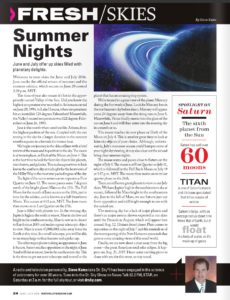June and July offer up skies filled with planetary delights
June and July offer up skies filled with planetary delights.
By Steve Kates
Welcome to your skies for June and July 2016. June marks the return of the official return of summer and the summer solstice, which occurs on June 20 around 3:34 p.m. MST.
This time of year also means it’s hot in the appropriately named Valley of the Sun. Did you know the highest temperature ever recorded in Arizona occurred on June 29, 1994, in Lake Havasu, when temperatures hit an incredible 128 degrees Fahrenheit? Meanwhile, the Valley’s record temperature was 122 degrees Fahrenheit on June 26, 1990.
June is the month when sunshine hits Arizona from the highest position of the sun. Coupled with the sun resting in the sky for a longer duration in the summer months equates to a formula for intense heat.
We begin our journey in the skies of June with a brief review of the moon and its position in the sky. The moon is at its new phase, or Dark of the Moon, on June 4. This is the best time to look for faint sky objects like planets, star clusters, and galaxies. This is also a great time to look low in the southern sky at midnight for the best views of the Milky Way in the most star-packed region of the sky.
The light of the moon returns as we experience First Quarter on June 12. The moon passes some 7 degrees north of the bright planet Mars on the 17th. The Full Moon for the month of June occurs on the 20th, just in time for the solstice, and is known as a full Strawberry Moon. This occurs at 4:03 a.m. MST. The June moon then moves on to Last Quarter on the 27th.
June is filled with planets too. In the evening sky, Jupiter is high in the south at sunset. Mars is also low and bright in the southeastern sky. Mars is now at its closest to Earth since 2005 and makes a great telescopic object to view. Mars is some 47,000,000 miles away from the Earth at this time. In a small telescope, you will be able to see many large surface features and a polar cap.
The other major planet making an appearance in June is Saturn. Saturn reaches opposition on the night of June 3 and will rise at sunset, low in the southeastern sky. This is the time to get out your telescope and marvel at the planet that has an amazing ring system.
We’re treated to a great view of the planet Mercury during the first week of June. Look
for Mercury low in the northeastern sky before dawn. Mercury will appear some 24 degrees away from the rising sun on June 5. Meanwhile, Venus finally moves into the glare of the sun on June 6 and will then enter into the evening sky in a month or so.
The moon reaches its new phase or Dark of the Moon on July 4. This is another great
time to look at faint sky objects of your choice. Although, unfortunately, July’s monsoon season could hamper some of your night sky viewing, it may also clear out the air and bring clear summer nights.
The moon waxes and passes close to Saturn on the night of July 9. The moon is at First
Quarter on July 11, which is followed by the Full Buck Moon on July 19 at 3:57 p.m. MST. The moon then moves on to its last quarter phase on the 26th.
There are still some great planets to view in our July skies. We have Jupiter high in the southwestern sky at sunset, followed by Mars bright in the southeastern sky. Just to the left of Mars, we see Saturn just out from opposition and still bright enough to see with the naked eye.
The morning sky has a lack of major planets and there’s no major meteor shower expected in our skies until the Perseids in August, which will appear best around Aug. 12. Distant dwarf planet Pluto comes to opposition on the night of July 7 and this reminds us of the recent passing of the New Horizons spacecraft that gave us some amazing views of this small world.
Finally, we are now about a year away from the big event––the great American total solar eclipse. It happens on Aug. 21, 2017. I have some exciting plans to share with you for this event, so stay tuned
Spotlight on Saturn
- The sixth planet from the Sun
- Saturn has well over 60 moons.
- Titan is one of Saturn’s moons and it’s been speculated that it has oceans of octane
- Saturn is large, with an average radius about nine times that of Earth, but it would float in a body of water, as it’s made up of gases
Summer Solstice
Summer begins on June 20 at 3:34 p.m. MST
- Hey Sol Sistere––The word solstice is derived from two Latin words: “sol” (meaning sun) and “sistere” (to cause to stand still). The perception that the “sun stands still” comes from the shadow on the sundial changing minimally on and near the solstices.
- The during summer solstice the sun is farthest north of the celestial equator, at 23 degrees 26 minutes of arc
Related posts
Leave a Comment
You must be logged in to post a comment.







